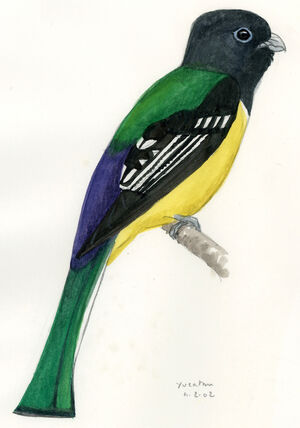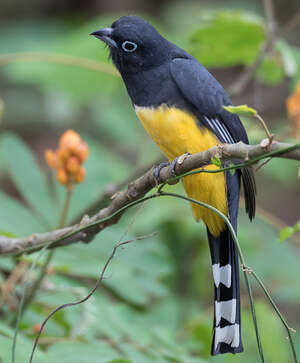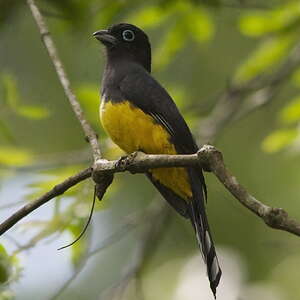Black-headed Trogon
Trogon melanocephalus - Trogon à tête noire
Identification
The Black-headed Trogon probably forms a superspecies with the White-tailed Trogon, the Citron Trogon, which can be confused with it, and the Baird's Trogon. The male has a black head, crown, nape, forehead and throat of magnificent black, and the border with the anthracite breast is not very distinct. A strong pale blue beak the same color as the orbital circle are distinct signs of the Black-headed Trogon, the iris is dark brown; the Citron Trogon with which it is neighbor does not have an orbital circle and has a yellow iris. The breast is separated from the yellow belly by a white line, gray marks are sometimes visible on both sides of the belly along the coverts. The mantle is metallic green with grayish traces in the center, little by little the green turns to a very intense blue-turquoise on the back, the rump and the uppertail-coverts. The scapulars are blue-green, the coverts are black and remarkable detail, they do not show any vermiculation. The black remiges show white edging on the primary remiges. The three pairs of lower rectrices are white with a wide black base on the first pair under the belly. The bird can show small black diamonds between each pair of rectrices, the tip of the tail is outlined with a black horizontal line. The upper rectrices are blue-green and also end with a black horizontal line. The tarses are blue-gray and most often hidden under the belly. The female has the distinctive mark of almost all trogon females, a black culmen, the beak being pale blue, the same brown iris surrounded by a blue orbital circle. The crown and the nape are gray like the chest, the parotids are anthracite, in fact the light, the age and the observation conditions make Mrs. Black-headed Trogon appear rather gray-headed! The same white mark is found that separates the chest from the yellow belly.The back is gray, the covers are also gray, the primary remiges showing the same white emarginations as seen in their companion. The first pair of lower rectrices, just underneath the belly is black and ends with a broad white mark, the other two pairs appear more white with a smaller black base, the tip of the tail is barred with a horizontal black stripe, the upper rectrices are gray. The juveniles look like their mother, the belly and chest are more messy mix of gray, white and yellow, with age the young males will gradually take on the livery of their father, the Black-headed Trogon.
Subspecific information monotypic species
Foreign names
- Trogon à tête noire,
- Trogón cabecinegro,
- surucuá-de-cabeça-preta,
- Schwarzkopftrogon,
- kormosfejű aranytrogon,
- Zwartkoptrogon,
- Trogone testanera,
- svarthuvad trogon,
- Svarthodetrogon,
- trogón čiernohlavý,
- trogon černohlavý,
- Sorthovedet Trogon,
- naurutrogoni,
- trogon capnegre,
- trogon czarnogłowy,
- Черноголовый трогон,
- ズグロハグロキヌバネドリ,
- 黑头美洲咬鹃,
- svarthuvad trogon,
- 黑頭美洲咬鵑,
Voice song and call
Habitat
The Black-headed Trogon is not a fan of altitude and, generally, it is not found above 1,000 m. It likes semi-open areas, secondary forests and edges of wooded zones but in Belize it is also observed in primary forests. It is an all-terrain bird, it can be observed near mangroves and also close to cultivated areas or pastures.
Behaviour character trait
Dietfeeding habits
Like all Trogons, the Black-headed Trogon is both a frugivore and an insectivore. It loves to eat the seeds of Meliaceae (one of the most well known being the mahogany), various berries, and the fruits of different varieties of Cecropia.
In El Salvador, it takes advantage of its near Picidae neighbors that open up oranges and eat the remaining fruits! Its diet will become insectivore during its offspring's feeding period, with orthoptera, caterpillars, dragonflies, and all varieties of insects augmenting its menu.Reproduction nesting
May to June in Belize, March to July in Costa Rica. American ornithologist Alexander Skutch (1904-2004) observed in 1948 in Guatemala, a group of ten male Black-headed Trogons, perched at low height while calling, and bobbing their tails vertically.
Similar observations have been made of the White-eyed Trogon, the Elegant Trogons, and the Collared Trogon, which are all similar to observations made in Africa of members of the Apaloderma genus; these manifestations are likely related to mating displays. The nests are often dug in low-height tree termite mounds, between 1.50 and 8 meters high. Alexander Skutch observed the construction of one nest on 8 April 1948 in Guatemala; the pair chose a termite mound of about 60 cm in height and 40 cm in thickness. They spent 6 days digging the tunnel, taking turns working, in an interesting detail, when one of the birds went away, presumably to feed, the other stayed close by, without working, and waited for their mate to return. The tunnel ended up being 30 cm long, and the nest was finished on 14 April. The first egg was laid on 21 April, and the third egg of the clutch of three eggs arrived on 23 April. Incubation lasted 19 days, and the pair took turns incubating; the young birds, fed by both parents, began to have feathers at 11 days, and looked like real trogons at 15. Nineteen days later, they were able to fly without going too far from the nest.Geographic range
Threats - protection
IUCN conservation status
concern
in the Wild
threatened
evaluated
LC, the Black-headed Trogon is evidently well adapted to its current environment and to humans, as with all Trogons, deforestation remains the primary concern for this species.
Sources of information
- IOC World Bird List (v15.1), Gill, F and D Donsker (Eds). 2025-12-07.
- A Natural history of the Trogonidae, Joseph M.Forshaw Albert Earl Gilbert
- Vol. 6 - Handbook of the Birds of the World, Josep del Hoyo-Andrew Elliott-Jordi Sargatal
- xeno-canto, Sharing bird sounds from around the world,
- Avibase, Lepage Denis
- HBW Alive,
- Wikipédia, Wikipedia, The Free Encyclopedia
- BirdLife International, BirdLife International
- The internet Bird Collection,
Other sources of interest
 Specification sheet created on
01/08/2023 by Anne et Gabriel Leboff
Specification sheet created on
01/08/2023 by Anne et Gabriel LeboffTranslation by AI Oiseaux.net
© 1996-2025 Oiseaux.net
- Accipitriformes
- Aegotheliformes
- Anseriformes
- Apodiformes
- Apterygiformes
- Bucerotiformes
- Caprimulgiformes
- Cariamiformes
- Casuariiformes
- Charadriiformes
- Ciconiiformes
- Coliiformes
- Columbiformes
- Coraciiformes
- Cuculiformes
- Eurypygiformes
- Falconiformes
- Galliformes
- Gaviiformes
- Gruiformes
- Leptosomiformes
- Mesitornithiformes
- Musophagiformes
- Nyctibiiformes
- Opisthocomiformes
- Otidiformes
- Passeriformes
- Pelecaniformes
- Phaethontiformes
- Phoenicopteriformes
- Piciformes
- Podargiformes
- Podicipediformes
- Procellariiformes
- Psittaciformes
- Pterocliformes
- Rheiformes
- Sphenisciformes
- Steatornithiformes
- Strigiformes
- Struthioniformes
- Suliformes
- Tinamiformes
- Trogoniformes

































